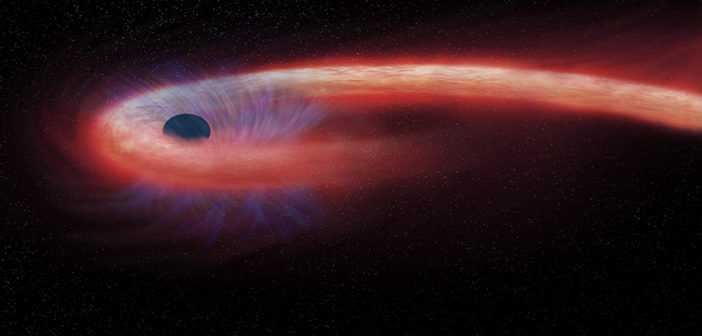Tucked away in the deep corners of the universe may lie intermediate-mass black holes: the missing link between supermassive black holes, which sit at the centers of most galaxies, and stellar-mass black holes, which result from supernovae. Could white dwarfs help us find these elusive enigmas?
Tidal Tale Signs of an Intermediate Black Hole
Though intermediate-mass black holes have been challenging to find, they may reveal themselves when they rip apart a white dwarf and cause a burst of nucleosynthesis, the process that transforms light elements into heavier elements. Modeling the interaction of intermediate-mass black holes with white dwarfs can give us clues to what the electromagnetic signature of these events looks like, which we can then search for with telescopes.
However, the 3D simulations we’d ideally use for this work are computationally expensive. Modeling these interactions requires looking at timescales from microseconds to hours to capture detailed nuclear physics and massive accretion flows. We also need to model length scales from tens of meters to thousands of kilometers to study hotspots of nuclear ignition as well as track the white dwarf throughout its orbit. Though 3D simulations might capture the physics most accurately, working in 2D reduces the computational cost and eliminates factors that may not be vital to understanding the system as a whole. A team led by Peter Anninos (Lawrence Livermore National Laboratory) simulated these tidally disrupted white dwarfs in 2D to test how well these simulations stack up against their 3D counterparts.

The gas density over time for the 0.15 solar mass helium white dwarf with a fairly strong tidal force. The top panel is at a time of 1.25 seconds, the middle at 1.36 seconds, and the bottom at 1.45 seconds. The color bar represents the density of the gas in g/cm-3. The x and y axes plot distances, which are given in terms of 104 km. [Anninos et al. 2022]
Only Time Will Tell
The team simulated the interaction of a 0.15-solar-mass helium white dwarf and a 0.6-solar-mass carbon–oxygen white dwarf with intermediate-mass black holes at various distances — which correspond to various tidal strengths — and observed the conditions that triggered nucleosynthesis in both helium and carbon–oxygen white dwarf encounters.
After setting the initial conditions at a wide range of spatial scales, the authors ran time forward to see when specific elements were formed and when detonation (the start of nucleosynthesis) occurred. In the various scenarios, helium burned to carbon before detonation occurred, and the rising gas temperature triggered a detonation wave that burned carbon, oxygen, and their byproducts into nickel and iron.
Compression Conclusion
Anninos and collaborators found slight differences between the processes that trigger nucleosynthesis in the different strength interactions. Overall, they concluded that detonation of nucleosynthesis is mainly triggered by adiabatic compression — compression without a change in heat. Their tests between helium and carbon–oxygen white dwarfs showed very little difference in their behavior.

Line profiles of the density of the helium (black), carbon (magenta), oxygen (green), calcium (blue), and nickel (red). The top panel shows densities just before the detonation and the bottom shows after. [Anninos et al. 2022]
Citation
“Resolution Study of Thermonuclear Initiation in White Dwarf Tidal Disruption Events,” Peter Anninos et al 2022 ApJ 934 157. doi:10.3847/1538-4357/ac7b87

